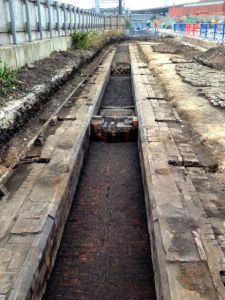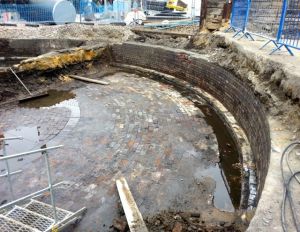Crossrail’s archaeologists don’t just dig up ancient skeletons from plague pits in the City of London, they also cover more recent events. Witness their dig just west of Paddington station that uncovered the remains of an early Great Western Railway locomotive depot.
It came complete with inspection pits and a turntable pit – the second that’s been excavated in recent years, with Network Rail’s discovery of York South depot’s pit a couple of years ago.
Crossrail reckons the uncovered remains date from around 1850, when the GWR still used broad-gauge tracks. (They were converted to standard gauge by 1896.) The depot was demolished in 1906 which was a time when the GWR was hugely expanding its London facilities.
An inspection pit from Brunel’s Westbourne Park locomotive shed. CROSSRAIL.
Old Oak Common depot dates from this time and is still used by First Great Western. Crossrail itself took over the locomotive part of the depot, demolishing the remaining turntable (once one of four) in order to build a factory to make concrete tunnel lining segments. Also dating from 1906 are the impressive girder bridges that cross main line on its approach to Paddington.
At Westbourne Park, the 45-ft diameter turntable pit dates from the 1881/2 while the engine shed and workshops are slightly earlier, being built in 1852/3. Crossrail says the engine shed was 202 metres long (not that the GWR was a metric organisation) and had four roads with inspection pits along the full length.
The remains of the turntable at Westbourne Park. CROSSRAIL.
Crossrail Lead Archaeologist Jay Carver said: “Isambard Kingdom Brunel’s Great Western Railway is the most complete early mainline railway in the world. Whenever we expose parts of the original infrastructure it is vital to record these for posterity and the history of rail in this country. Using the latest 3D scan technology provides a permanent and accurate model Brunel’s distinctive architectural legacy.”
The shed is soon to be covered over because Crossrail plans to use the site for turn-back sidings. The area will also include a replacements bus depot and concrete batching plant.

